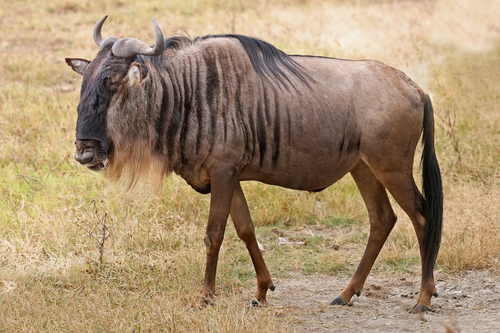
Blue Wildebeest
The blue wildebeest, or Connochaetes taurinus, is a migratory marvel of Africa's plains. Renowned for their impressive herds and striking bluish-gray coats, these grazers sustain ecosystems by fertilizing soils and providing prey for predators, embodying the vibrant pulse of the savanna.
15-20 years
Lifespan
136.0 - 272.0 kg
Weight
Brown, Black, Tan
Color
50 mph
Top Speed
Least Concern
Conservation Status
Stable
Population Trend
Characteristics
The Connochaetes taurinus, commonly known as the blue wildebeest, inhabits the grassy plains and open woodlands of southern and eastern Africa. These migratory ungulates are known for their robust, muscular build, distinctive bluish-gray coat with vertical black stripes, and a large, box-like head. They form massive herds and play a crucial role in the ecosystem by facilitating nutrient cycling and supporting predator populations.
Distribution Range of the Blue Wildebeest
The species Connochaetes taurinus, commonly known as the blue wildebeest or brindled gnu, is native to the African continent, primarily found in the southern and eastern regions. Its geographical distribution spans across countries such as Kenya, Tanzania, Botswana, Namibia, Zimbabwe, and South Africa. They are notably abundant in the Serengeti ecosystem of Tanzania and Kenya, where they partake in the well-known Great Migration.
Blue Wildebeest's Habitat
Environmental Conditions
Blue wildebeests inhabit open grasslands and savannas, where they can graze on short grasses. These regions typically have a tropical or subtropical climate with distinct wet and dry seasons that influence the availability of water and grazing areas. The species thrives in areas with ample water sources and prefers habitats that provide both grazing and cover from predators.
Ecological Niche
As grazers, blue wildebeests play a crucial role in their ecosystem by influencing the structure of grassland habitats. They maintain the grassland ecosystem through their grazing habits, which can encourage the growth of certain grass species and impact other herbivores' food availability. Wildebeests are also prey for large predators such as lions, hyenas, and crocodiles, making them a vital component of the savanna food web.
Copyright @ Nature Style Limited. All Rights Reserved.
 English
English